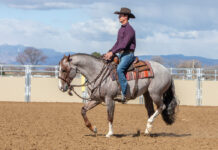 What goes on in the mind of a horse show judge? Many exhibitors envision a hardened official with a jaded outlook, someone who scrutinizes every moment of every performance. But that’s generally not the case.
What goes on in the mind of a horse show judge? Many exhibitors envision a hardened official with a jaded outlook, someone who scrutinizes every moment of every performance. But that’s generally not the case.
“I think one misconception people have is that they think the judge is against them, but actually the judge is your biggest supporter,” Schulman says. “We’re always rooting for the competitor. I think riders might not get so nervous if they realized this.”
In fact, because the majority of judges have spent years competing in the show ring, they know what it’s like to endure disaster. They’ve felt the humiliation of a rambunctious green horse and the disappointment of a jump rail plunking to the ground. Schulman says that most judges feel pangs of empathy when someone is enjoying a lovely round over the jumps, or cruising around a flat class, only to have something suddenly go wrong. “Believe me, at those times, no one feels worse than the judge,” she says.
Another misconception Schulman would like to eradicate is the notion that sometimes a judge simply doesn’t like a particular horse or rider. Instead, a lack of ribbons is more often due to some fault in the horse’s performance or in the rider’s position. She offers that, “I might have a very positive impression about a certain horse or rider except for one thing.”
At a large show, that one thing could equate to a lack of ribbons. So the rider leaves, feeling as if the judge was somehow prejudiced against her horse. “Unfortunately,” Schulman explains, “at a show there just isn’t the time or the opportunity for me to explain to the rider what needs to be changed or improved.”
Although riders can improve their show ring skills by attending clinics and judging seminars, and taking lessons with a professional trainer, Schulman does offer a bit of first hand advice. “Play to your strong suit,” she states. “For example, if your horse has a rough sitting trot, and it’s uncomfortable to sit, don’t come into the ring and sit the trot through your opening circle. There’s no rule that says you must sit the trot. Instead, demonstrate what you and your horse do well.”
By heeding Schulman’s advice, and understanding the mindset of the typical horse show judge, you can ride your way to more blue ribbons.






Good to know! I never really looked at judges that way before.
I think the difficulty in dressage, at least at the upper levels, is the prejudice against non-Warmbloods. Now, I know they can deny the influence breed has, but gaits are very important in dressage and how can a QH or even a TB beat a warmblood? I think its unfortunate but inevitable.
Cool. Thanks for the article!
I always like reading things from the judge’s viewpoint. It’s good to know they are our friends. Maybe I won’t be so nervous!
They have a softer side? Just kidding. This does make sense but not all judges are perfect and I’m sure that there is bias sometimes. And I think it would be a great idea if people knew why they didn’t place.
interesting article
Great Article,although I don’t show.
I’ll ne entering the show world soon and I am so glad I came across this article before hand! Thank you so much for it! I bet this will make me feel more confident and less nervous!! I’m very glad to know that judges are our friends. It’s comforting to know they WANT us to do well. ^_^ Thank you.
Interesting article. I have always wondered if the amount of silver on a western saddle influences the judge in any way in the pleasure classes. And, why are all the saddles light colored? Is that a rule? Just wondering.
I dunno… At my last show a judge reallllly liked the other competitor and as I had won the first class she was LOOKING for me to do something wrong, so she said that my horse was not supposed to jump the jump and that he should’ve trotted over it?! I was soooo mad, I hope I never see that judge again!
This article really helped me understand. I had no idea the judge was actually hoping I would do well! I guess us riders just automatically assume that the judge has ice cold eyes, very strict, marking down every wrong move we make, and thinking “what is she doing? your supposed to shorten your stride after that line and bluh bluh bluh! haha. This article gave me a lot of confidence for this year’s shows, now I am not so nervous, after thinking about the judge in a bad way for two years! Thanks for the article.
This is absolutly helpful. I’m going to my first real show in 2 weeks, and I’m trying to read all about what I can do to help myself. It does help knowing that the judge isn’t against you for what you look like.
this helped so much, it answered so many questions i had. Along with making me relize so many things i never even thought of
How about those judges who pin blue ribbons on those Western Pleasure horses who are loping in 4-beat and whose noses are down around their knees instead of the tips of ears never below the level of the top of the withers (as stated in AQHA rulebook)? How about those judges who pin the Dressage horses who are so overbent, behind the vertical that they can’t see in front of them?
It’s nice to hear all of these things from someone who has lots of judging experience!